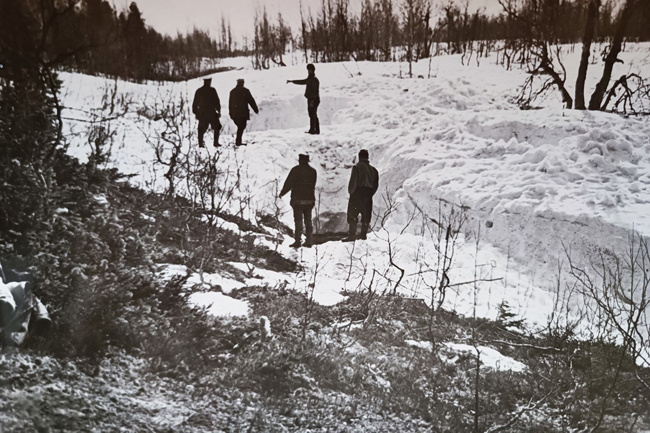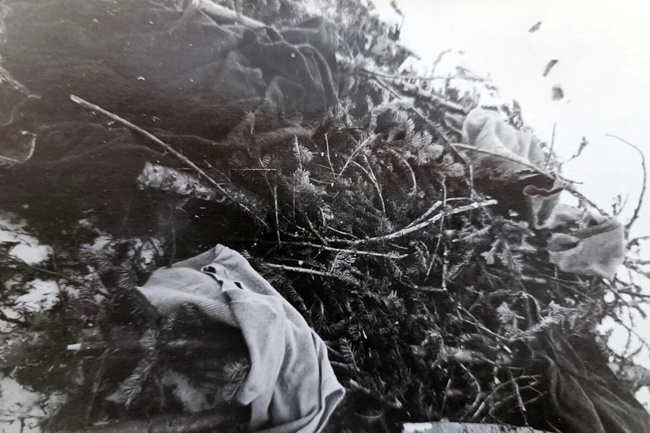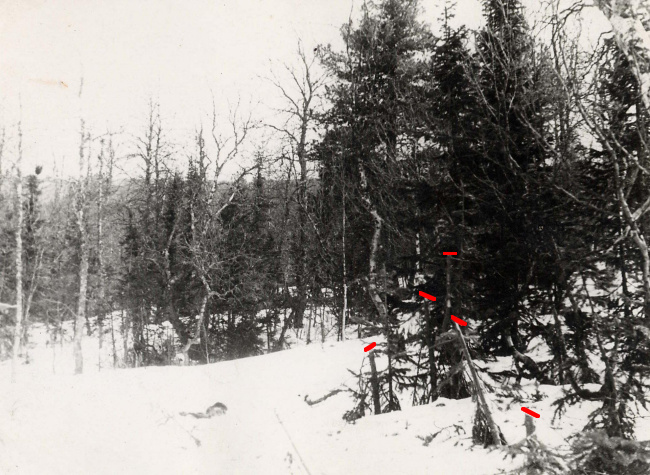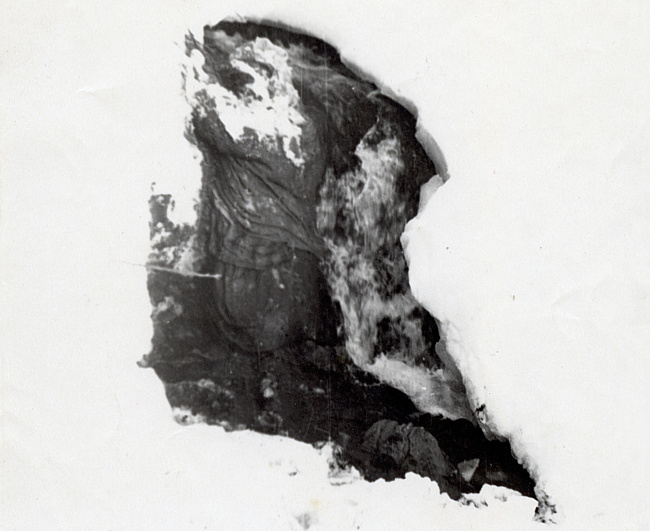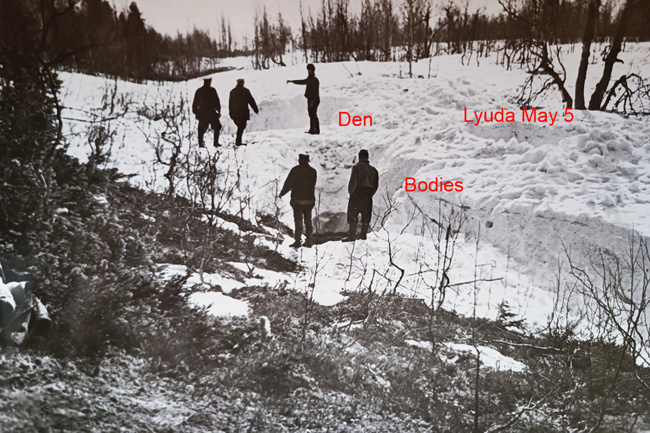
New photographs from 1959
How often do we get new information on a 66 years cold case?
In may 2025 two unpublished photographs were shown during a meeting in Yekaterinburg by the searcher who found the body of Slobodin, Master of Sports of Tourism, Vladislav Karelin. He was friends with Evgeniy Maslennikov, the head of the search from February 24 to March 10, 1959. Maslennikov's diaries (notebook 1 and notebook 2) contain the best information there is on the search of the Dyatlov group. When he passed away his widow gave two notebooks to Vladislav Karelin. Inside there were loose pages. Between some pages that have stuck together, Karelin recently found two unpublished photographs probably taken by lead investigator Lev Ivanov himself and given to Maslennikov.
Photo 1: If you are familiar with the case you will see the excavation holes and people seen on another photograph too.
Photo 2: The den also contains the items that are described by Maslennikov in the Protocol of inspection of the scene where the bodies were found:
Up the creek in a distance of six meters along the tracks a den was found at a depth of 3 to 2.5 meters. The flooring consists of 14 fir tree and 1 birch tops in the snow. Items were found on top of the flooring.

Drawing showing the items on top of the flooring
- Leg of black ski trousers
- Whole woolen light Chinese sweater
- Whole insulated brown woolen sweater
- Brown trousers torn at the legs
- - 6 m - bodies
- 2 -
Step 1: Hurrah! New information that doesn't favor anybody's theory (this is short lived), we are all united and hopeful that new information still exist somewhere (this we all agree on) and that it can see the light of day.
Step 2: I diligently take the new photographs and go to the existing database with the known search photographs, and all the hell breaks loose. There is a lot of commotion, people can not make sense of the sequence of events in day when the den and the last bodies were found. I will try to explain. This was the existing order of photographs before the new ones were published → Archived 1
This should give you pause → Archived 2
Before jumping to conclusions I listen to what the Russians have to say. The ones that tried to give innocent explanation said that the branches in the den were merely dusted from the snow for the photo and not put there by the conspirators.
Those in favor of a brutal murder and conspiracy went straight for the jugular claiming that after Lyuda was found, they didn't hurry but left the excavation for the remaining to the next day because they had to put them bodies in the creek. Or else in this photo they are standing on top of the bodies, since it was taken before the den and the bodies were found.
But who says that this is the correct order → Archived 2? It turns out I do. This is the archive I inherited from Igor Pavlov and now it is time to correct it. You need to understand that we do not have negatives or meta data. No one knows who, when, where and what is on these photos. Same applies for these trek photos of the Dyatlov group, and as you can see some very important photos don't come from films. We call them loose photos because they only appear glued in home albums. We have to deduct that they are from the fateful trek.
Step 3: I rearrange the photos but not before confirming with Askinadzi what he remembers. Vladimir Askinadzi was the leader of the 6th search shift of UPI students. They had lost hope and preparing to go home. The next shift in Yekaterinburg was getting ready to replace them.
On May 5th Askinadzi saw the Kurikovs discussing small thawed-out twigs, and then going to Colonel Georgiy Ortyukov. The Mansi found charred and cut clothes and pointed out cut tops of young spruce trees.
May 5 Radiogram: "To Prodanov: At 9:30 am on May 5, Kurikov discovered black cotton tracksuit pants without the right leg in 50 meters to the south-west from the cedar, on the location of the chopped spruce grove at the depth of 10 cm. The pants are charred on the backside. The right leg has been cut with a knife. He as well discovered the left part of a women’s sweater of light-brown worsted wool. The second part with the right sleeve was cut with a knife and has not yet been discovered. The sweater belonged to Dubinina. At 11 am I decided to excavate the ditch 10 meters to the south-west from the chopped spruce grove. A plot with an area of 20 sq. meters at the depth of 2.5 meters."
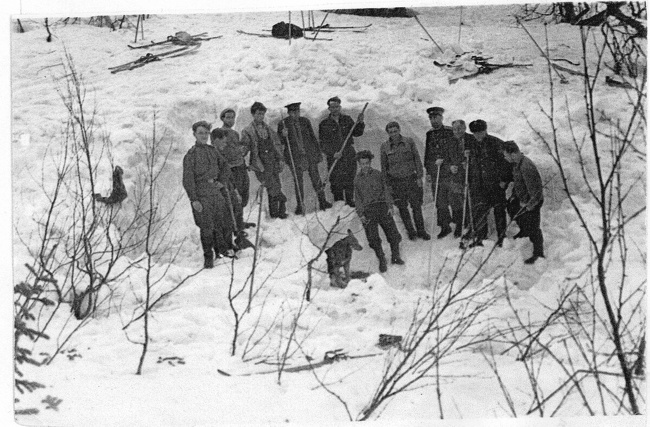
The hole is not 2.5m (8 feet) deep yet.
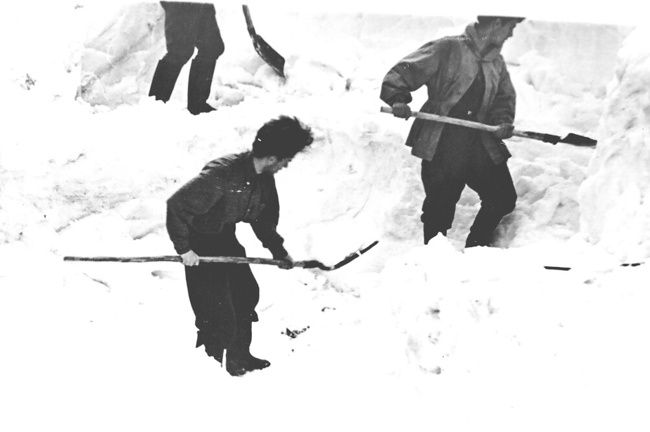
More digging, Suvorov in the foreground
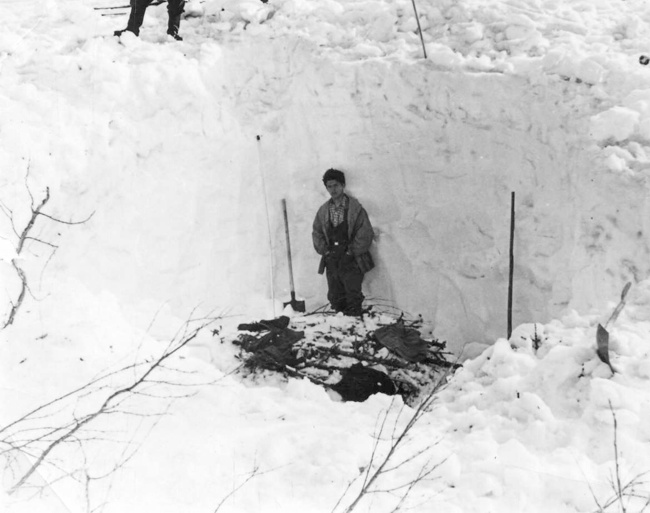
Now it is as deep as described in the Radiogram, 2.5m (8 feet)
- 3 -
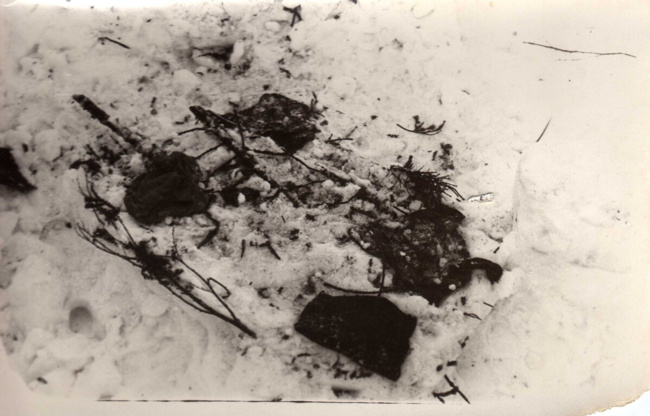
The den on May 5, branches covered with snow.
Askinadzi: "Having found the den, we went to the camp, where we had dinner. It probably took us about two hours. Then, some people stayed in the camp, and I went to the excavation, not paying attention to who and how many were going with me. I worked with the probe for several minutes (no more than 10 minutes) until I found Lyuda. And then an explosive situation began - everyone who remained in the camp came running."
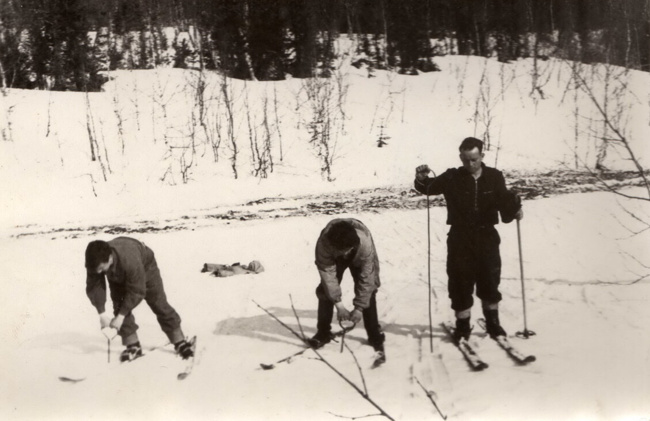
Fyodorov, Suvorov, Gilevich. Mohov commentary: "Working with probes. The searchers stand across the stream, facing the pass, in time the action takes place between the excavation of the den and the bodies."

Mohov commentary: "Corpses in the stream. Excavation of a hole in the evening."
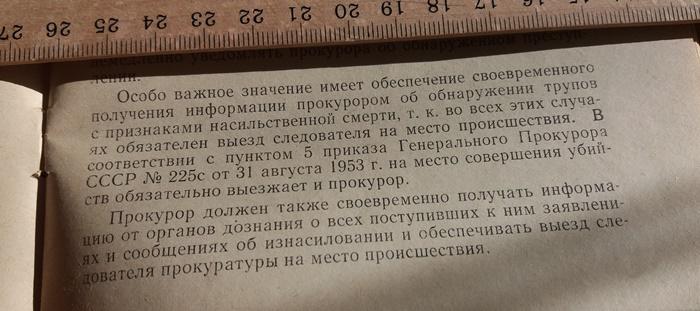
"It is especially important to ensure that the prosecutor receives information in a timely manner about the discovery of corpses with signs of violent death, since in all these cases the investigator must travel to the scene of the incident. In accordance with paragraph 5 of the Order of the Prosecutor General of the USSR №225s of August 31, 1953, the prosecutor must also travel to the scene of the murder."
- 4 -
"20-30 cm next to Lyuda we saw another head. We couldn't do much without pulling her body out. She was placed her in a special hole we dug up for her, covered with some blanket. The excavated snow to open up the water and saw that all three remaining bodies were there. Not having to look for more bodies, we covered the remaining 3 in the water with a tarp so the morning sun doesn't damage them any further and waited for the investigators to arrive."
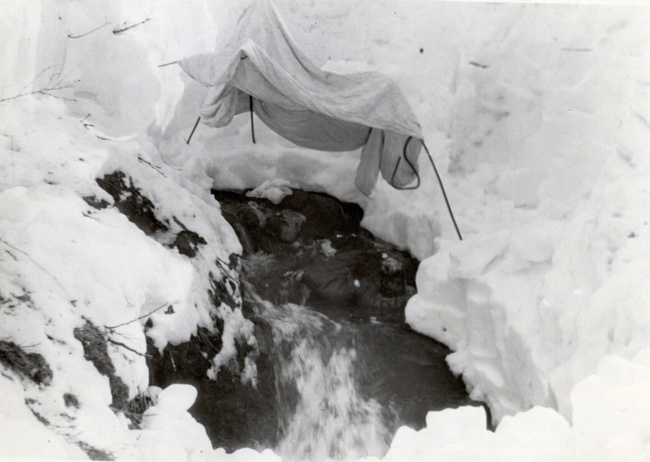
May 6, an awning that protects corpses from the sun
In the morning of May 6 investigator Vasiliy Tempalov arrives on the pass and writes the Protocol of inspection of the scene where the bodies were found.
On May 7, Lev Ivanov and coroner Boris Vozrozhdenniy arrived at the pass. Victor Potyazhenko was instructed by the command post to fly in and transport the corpses. He was met by Ortyukov, who informed him that it was also necessary to bring a monument to the pass on the return flight, together with any materials needed for its mounting. His commanding officers confirmed the mission of transportation of the bodies, but not that of the monument, so Potyazhenko refused. Moreover, his commanding officers approved the transportation of the bodies only if they were placed in coffins, in accordance with the sanitary guidelines for transportation of corpses.
Finally, on May 8, the corpses were transported from the pass, and work began on dismantling the search camp.
On May 9, at the N-240 infirmary morgue, Vozrozhdenniy, with Ivanov and Genrietta Churkina in attendance, conducted the forensic examination of the bodies of Kolevatov, Zolotaryov, Thibeaux-Brignolle, and Dubinina. Various injuries were found on all of them, but the degrees of severity on three of the bodies were of a fatal nature. The cause of death was written up in the autopsy reports, but nothing surrounding the bodies could explain what killed them.
Question: When do you think these photos were taken?
Askinadzi: Ivanov left the pass on May 8, I left it on May 10 and the rest on May 13. Many photos were made after the bodies were taken away from the pass. If these are Ivanov's photos then then they must have been taken on May 8. The snow has significantly melted away.
Question: There is a big hole where the den was found. Why didn't you widen this hole to search for the bodies, how did you just hopped to the next hole?
Askinadzi: After dinner I started probing from the den down the flow of the river. As I said, I hit Lyuda's head very shortly after that. Only then we started digging, not before, not on a hunch.
Please check the new revised order of the search photos.
My own take is that putting the pieces of the puzzle in their correct place not only helps paint the big picture but also saves us from drawing ridiculous conclusions.

